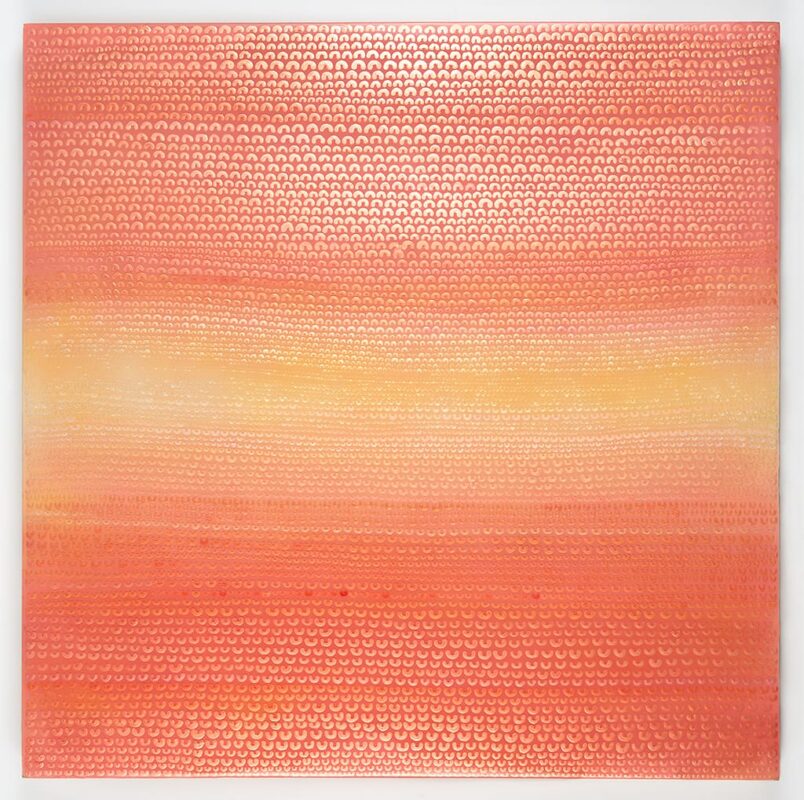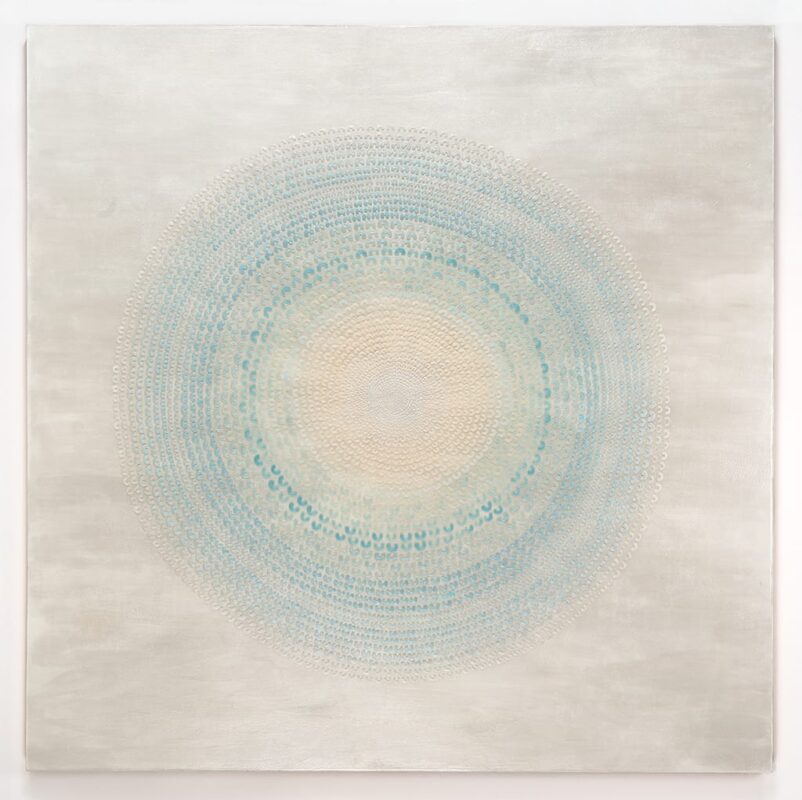Making art has the power to bring us naturally and powerfully into the present moment, but daily practice of mindfulness can open us more directly to an endless inner source of fresh ideas. Mindfulness practice can relieve the daily mental stress many artists and creative people face. It can also furnish us with skills to transcend the clutter of the mind and improve our sense of well-being, satisfaction, and artistic growth.
My early years as an artist
I wasn’t a star pupil in art school. I was not one of those students who carried those black, hard-backed sketchbooks everywhere, bursting with sketches, paintings, and collages. I was not the kind of art student who spent every waking hour making things. I was a diligent, attentive student. I did the assigned work, attended every class and loved it all. But when I started, I hadn’t the first clue how to turn out original work. After graduation, I went through a difficult period in my creative life. I knew I wanted to devote my life to making art. But crushing self-doubts and critical voices plagued me every time I tried to work in the studio. I showed up to the studio regularly and managed to get work done, but I suffered from inexplicable fatigue due to the inner emotional stress of these critical voices. I sometimes grew distracted and unfocused. I sought out self-help books and groups for creative people, and slowly and subtly things began to change.
Starting a daily practice
It was in yoga class that I first learned to meditate. I loved the calm, energized feeling I had after yoga class and the new sense of inner peace I felt after our meditations. In 1987, I started a daily meditation practice that continues to this day. It began very simply. I took a wool blanket from the thrift store and folded it into a cushion. I placed the cushion in my narrow clothes closet with the big window. I wrote out words of an Indian yogi on a card: “Making, making, some day made. Striving, striving, one day behold!” and taped it to the wall in front of me. And I sat in meditation. Every single morning.
Of course, I thought I would encounter that sense of peace and calm I’d experienced meditating in yoga class. But no. At first all the negative voices took over my head. I couldn’t hear anything else. I felt overwhelmed by feelings of insecurity and inadequacy, which I had been escaping with music, food, and other distractions. Now I had to sit down and actually pay attention to these feelings? It was horrible. In fact, it was so excruciating, I could only sit for five minutes at first.
If this is your experience, keep with it. I promise you it will get easier.
Eventually, I was able to settle into moments of peace. It was as if by being with these voices, not trying to escape them, they eventually settled down and got quieter. By realizing that I had deep-seated negative feelings, I could separate myself from them. Then I could begin to look at them dispassionately rather than identify so strongly with them.
Over time, my work itself has taken on a meditative quality. I have become so filled with this wonderful sense of well-being from meditation practice that I want to share it with others.
The benefits of becoming aware
When we practice meditation, we naturally become more aware– aware of our thoughts, our unconscious habits, the feelings and thoughts of the people around us, our impact on others. And the longer we practice, the more we notice. We notice subtle things that were always there – we just couldn’t see them before. Sort of like someone whose fuzzy vision becomes clearer with a new pair of glasses.
This type of deep noticing can have a profound impact on our creative work. As Paul Valéry put it, “To see is to forget the name of what one is seeing.” By being fully present with what we are creating, we can move beyond preconceptions and habits and encounter the work afresh.
What is remarkable is that when we shine the light of awareness on a problem without identifying with it, this problem tends to become less daunting. In our calm awareness, insights and solutions naturally arise. We may be inspired to action, but the sense of willfulness and effort we may have formerly applied to similar situations. For example, in the past when I was frustrated with a painting, I might have pushed on through, painting over and over it even though I knew it wasn’t going well and I wasn’t enjoying it. I would apply my willfulness and work ethic, hoping for some kind of resolution. And sometimes that approach does work. But these days, when I am at an impasse, I am more likely to stop, sit quietly, close my eyes and go inward, allowing ideas to enter my head. It never takes long, and the most unexpected and delightful solutions present themselves.
A daily practice of meditation teaches us to discern between mind chatter and our inner wisdom. It is easy to get caught up in our thoughts, circling over and over with various possibilities and choices without gaining clarity. Without awareness, our thoughts drive us. Having your thoughts driving you is like being dragged around behind a wild unruly stallion. I am inviting you to learn how to get back in the saddle, and guide your mind by developing a respectful, cooperative relationship with it. When we can get some distance between our self and our thoughts, we can choose our thoughts.
If you have never spent time meditating before, you may find your mind to be a very messy place. Most of us have habits and patterns of thought that we unwittingly developed in our youth by simply imitating the patterns of thought of those around us. If your parents thought money was hard to come by or life was unfair, there’s a good chance you adopted these thoughts unquestioningly. If your family thought people were fun and friendly, it’s likely you feel the same way. Patterned thoughts become like grooves in our brain – neural pathways – that can create habits of self-criticism, fear, doubt, cynicism, pessimism or worry. We scarcely notice them because they are so ingrained in us. And if we don’t notice them, we can hardly be aware that it is those habits or patterns of thought that are driving the circumstances around us.
As our meditation practice develops, we cultivate a deep state of peace and equanimity, which we can draw upon at any time. And in some shining moments, we experience unbounded states of bliss.
A fresh mind
You know that feeling when you first wake up? When your thinking is clear and your mind is calm? Many people tell me that is when they have their best creative thinking. I know it’s true for me. When I have a challenging project before me, I like to devote at least 25 minutes on it when I first wake up following my meditation time.
Some people get that fresh mind from taking a shower. I think that’s why many people say they get their best ideas in the shower. I think it’s similar to meditation. Your body is washed clean and with it, your thoughts. You’re relaxed, you are not trying to think of anything in particular or do anything else. Your mind becomes clear. Ideas flow in.
Meditation can give you that “fresh mind” any time of the day, no water required. I call meditation a superhighway to new ideas and solutions. When you slow thoughts, observe thoughts, your mind can open to its higher centers of creative thinking.
Is mindfulness the same as meditation?
What is the difference between mindfulness and meditation? While mindfulness is being aware in the present moment, meditation is the means to cultivate mindfulness. It takes practice – just like learning to tie your shoelaces. When you were small, you may have struggled quite some time to learn this. But now you do it so effortlessly, you scarcely know the steps.
Imagine you have moved to another country and you take classes in the new language. One day, on the street, you find yourself naturally using phrases and words that had never popped out of your mouth before. It wasn’t something you necessarily learned in class, it was by continually being around the language and letting it soak into you, so that it became part of you.
Mindfulness in the studio
This daily practice of sitting meditation can also be applied to sitting to make art. Picasso used to say, “Inspiration exists, but it must find you well placed at your work.” To me, “well placed” means showing up regularly to the studio, without fail, even if I’m feeling some resistance to the idea. Because the first ten minutes of work is always the hardest. Once you get going, the work carries you.
On the other hand, I believe if you truly don’t feel like going to the studio and you long to do something else, it’s important to listen to that inner voice. I remember some artist friends quoting their graduate professor, “It’s better to be at the beach thinking about your studio than to be at your studio thinking about the beach.”
I have found that many artists struggle to find consistency in their creative practice. The first thing I recommend is setting aside 15 minutes to make art. Daily. I find that even the busiest people who truly want to make art can find 15 minutes a day. Consistency is key. Because your body, your mind, your heart and your soul get used to that time. It’s as if you were ready for it. The more you do it, the more ready you are.
The benefit of being consistent is that you find your mind is actually working on your art at other times, in the background, while you are doing other things. The creative problem-solving continues even when you are not actually in the studio.
Melting walls with your mind
A couple of years into my meditation practice, when I was still struggling in the studio with insecurities and self-criticism, I remember a big breakthrough. I was working on a very large painting. It was my largest painting to date and I had invested a lot of time and money making it. But the piece felt flat and unpainterly to me.
I remember one day looking at it and it felt totally unsolvable. I just hated the piece. And I could not think of how to solve it. I was feeling frustrated and discouraged and because I had spent so much on the materials, the thought of abandoning it didn’t seem a viable option. For some reason that day, I had the presence of mind to just stop and sit with it. Not try to think it through or solve it, just be present with it, as I would in meditation. And in that silence, I got an idea for something to try. Since it was about the worst painting I had ever made, I had nothing to lose. I was completely delighted with the results and full of exhilaration and fresh energy for the piece. I broke through what I call “the wall.”
“The wall” seems to happen over and over in creative work. It’s when you are at an impasse. You have already invested quite a bit into the project. So it definitely feels like more is at stake. It can feel like there’s no way out, no solution.
Sometimes the best way through is to do “nothing”. By nothing I mean to empty oneself and become receptive. Meditation can teach us that.
How to meditate
If you have not meditated, may I suggest this experiment?
Set aside five minutes each morning. As early as possible upon arising is easiest because your mind is still fresh and you do not have as much resistance to the idea. (I’m too busy, I don’t feel like it, it’s too hard.)
Find a comfortable and pleasant place to sit. One where you can sit in the exact spot every day.
And if you have a smartphone, I suggest setting a timer with a gentle ring so your mind does not need to be preoccupied with how long five minutes exactly is.
Before you start, settle yourself in. Ensure that your posture us upright, your chin ever so slightly turned down to elongate the back of your neck. Allow your shoulders to be comfortably loose and relaxed, with your shoulder blades on the same plan as your spine, rather than hunched forward. Can you can breathe easily and naturally without restriction? Then, gently close your eyes and just notice that breath. Pay attention as it fills your lungs quite easily and naturally, and then as it is expelled just as easily through your nostrils.
Thoughts will arise. About whether you remembered to take out the garbage last night, or the first appointment of the day, or that annoying thing your co-worker said yesterday. But you are not going to engage with those thoughts just now. You are going to notice the warmth of the breath as it gently flows in and out. And how your jaw has naturally unclenched and how every muscle is gently melting, releasing habitual tension. And the thoughts may come back: How long has it been now? Surely five minutes is up. I can’t sit here doing nothing! I have so much to do today! And then like a little child who has wandered off, you will gently take your mind by the hand and lead it back to the present moment.
If it helps, you can count your breaths. But just stay with the breath. And without noticing it, you have actually drifted into deep connection. You are not thinking. Then you notice that you are not thinking, and now you are thinking again. And so, you go back to your breath. Such is the task of a meditator. Like trying to take a knot out of a tiny thread with a needle. But hang with it. Please. It gets easier. Because you will untangle that knot and then that tiny thread will stretch out before you free of its knots. Before you know it, there is no thread at all.
The exalted state
It is only in learning how to quiet the mind that we learn how to quiet the mind. By this I mean, yes, one can get into these mindfulness states by making art but it usually happens just by chance. I have heard even experienced artists say that they dread getting started or dread going to the studio. Even though they can get into these wonderfully exalted creative states, getting started is painful. But it need not be that way. It can be effortless. And we can achieve that through practicing mindfulness, which is a brain state parallel to creativity. But instead of doing it by chance, we cultivate it intentionally.
Sometimes making art isn’t about the exalted state. Sometimes being an artist is about paying the bills, calculating your taxes, sending out emails, researching materials, organizing the studio, editing images, updating your website, applying for shows. When you practice meditation every day, you get to experience that exalted state, even if just for one moment, every day. No matter what.
About the artist Michele Théberge
Michele Théberge uses a wide range of media — drawing, painting, installation and interactive projects — to explore the connections between the material and immaterial worlds and to share the expansive calm experienced in meditation. Michele Théberge is a visual artist based in California’s San Francisco Bay Area. She is known for the quiet, meditative quality of her drawings, paintings and installations. Constructed from delicate materials such as paper, paint, fabric, mylar, foil and pins. Her works have been exhibited in museums and galleries worldwide, including the Museum of Kyoto, Sharjah Art Museum (United Arab Emirates), the San Francisco Museum of Craft and Folk Art and Montblanc Gallery, Hong Kong. She has been an affiliate artist at the Headlands Center for the Arts and a resident artist at the Morris Graves Foundation in Arcata, California in addition receiving grants from the Center for Cultural Innovation. A passionate arts educator, she wrote Seven Essential Practices for the Professional Artist (Editions FrI, Montreal) to inspire artists to create a consistent practice and satisfying life. You can download her book for free at www.themindfulartist.com She also has a YouTube channel with over 47,000 subscribers sharing her passion for painting and creative process.
Written by: Michele Théberge
michele@micheletheberge.com
www.instagram.com/micheletheberge/
Tags
Art / collages / drawings / illustrations / materials / meditation / Michele Théberge / mindfulness in art / painter / practice / visual artist
Art / collages / drawings / illustrations / materials / meditation / Michele Théberge / mindfulness in art / painter / practice / visual artist




